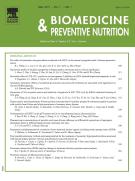Syringic acid exerts antiangiogenic activity by downregulation of VEGF in zebrafish embryos - 30/05/14

Abstract |
Angiogenesis, the formation of new blood vessels is essential for the conservancy of normal cell functions. The dysfunction and/or increase in angiogenesis may lead to uncontrolled cell proliferation of cells resulting in cancer. Inhibiting angiogenic factors using natural compound has substantial hope in cancer research. Hence, we investigated syringic acid (SA), a naturally occurring phenolic acid for its antiangiogenic property using the zebrafish embryo in vivo model. Morphological observations of the SA treated embryos were analyzed to evaluate the toxicity of the compound. RBC staining was performed to evaluate the ISV inhibition in zebrafish embryos. Further, to determine the mechanism behind ISV inhibition, a real-time reverse-transcriptase polymerase chain reaction and western blot analysis was done to evaluate VEGF mRNA and protein expression respectively. Our result showed that SA didn’t affect the morphology up to 50μM. The apparent angiogenic effect was seen from 20 to 50 μM, which significantly reduced number of circulating red blood cells in ISV region compared to that of control. At 50 μM there was no visible RBC present in the ISV region of the embryos. Further, Real-time PCR and western blot analysis showed, SA inhibited VEGF mRNA expression and protein expression respectively in a dose dependent manner. These findings altogether suggest that syringic acid may have antiangiogenic activity by down regulating VEGF mediated pathway thereby having potential therapeutic benefit and promises to be a weapon against cancer.
Le texte complet de cet article est disponible en PDF.Keywords : Antiangiogenesis, Syringic acid, VEGF, Zebrafish
Plan
Vol 4 - N° 2
P. 203-208 - avril 2014 Retour au numéroBienvenue sur EM-consulte, la référence des professionnels de santé.
L’accès au texte intégral de cet article nécessite un abonnement.
Déjà abonné à cette revue ?

